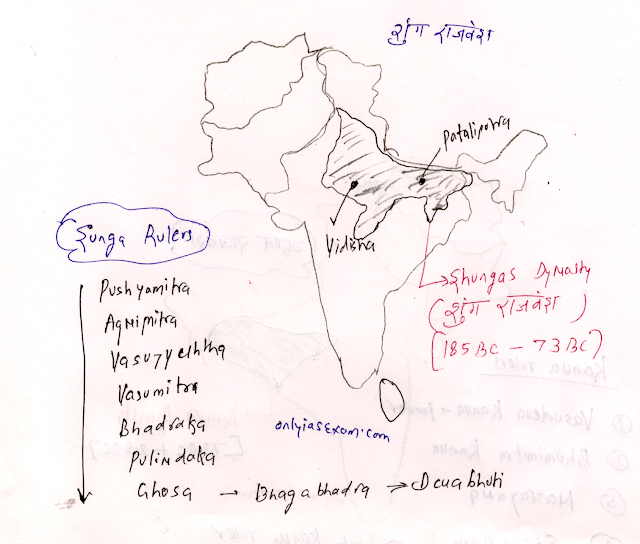Table of Contents:
- About Sunga Dynasty
- Rulers of the Sunga Dynasty
- Influences of the Sunga Dynasty on Society
- About Patanjali
- The decline of the Sunga dynasty
Notes on Sunga Dynasty [ 185 BC to 73 BC]:
The Sunga Dynasty was an ancient Indian dynasty that ruled parts of Northern and Central India from about 185 BC to 73 BC. The Sunga dynasty emerged after the decline of the Mauryan Empire, and it played a significant role in shaping the political landscape of ancient India.
The Sunga (Shunga) dynasty was established in 185 B.C by Pushyamitra Sunga, he was the ruler of Vidisha ( Ujjain, Madhya Pradesh ), and also he was the Brahmin army chief of the last Mauryan king ( Brihadratha ).
The initial Capital of the Sunga dynasty was Pataliputra, later it was shifted to Vidisha, Madhya Pradesh.
Sunga dynasty ruled over mostly Madhya Pradesh and the Vidarbha region of Maharashtra.
The following are the rulers of the Sunga Dynasty:
- Pushyamitra Sunga ( 185 BC to 151 BC)
- Agnimitra ( 151 BC to 141 BC)
- Vasujyeshtha (141 BC to 131 BC)
- Vasumitra (131 BC to 124 BC)
- Bhadraka (124 BC to 122 BC )
- Pulindaka ( 122 BC to 119 BC)
- Ghosha or Vajramitra ( 119 BC to 114 BC)
- Bhagabhadra ( 114 BC to 83 BC )
- Devabhuti (83 BC to 73 BC )
About Pushyamitra Sunga ( 185 Bc to 151 B.C):
Sunga or Shunga dynasty was established in 185 BC by Pushyamitra after killing Brihadratha (The last Maurya king).
Pushyamitra Shunga belonged to the Brahmin family of the Bharadvaja Clan.
Pushyamitra died in 151 BC. He ruled about for 36 years.
His son Agnimitra conquered the Vidarbha region of Maharashtra. King of Vidarbha region was Yagyasen. Kalidasa mentioned the love story of Malvika ( daughter of Yagyasen) and Agnimitra in Malavikagnimitram's book.
He successfully countered attacks from two Greek kings namely Menander and Demetrius.
He also successfully countered the attack from Kalinga ruler Kharavela. This information comes from the Hathigumpha cave inscription ( Odisha).
He followed the Brahmana religion, some historians believe that he persecuted to Buddhists and he also destroyed Stupas. Divyavandana’s book described that Pushyamitra destroyed the Buddhist Monasteries and their place of Worship. However, he also renovated the Stupas of Sanchi and Barhut.
He patronized Patanjali, the author of Mahabhasya.
Ayodhya inscription provides the evidence of Sunga dynasty, which gave information about the Ashvamegha Yagna performed by the Pushyamitr king. Patanjali was purohit of his Ashvamegha Yagya.
About Agnimitra ( 151 BC - 141 BC):
Agnimitra was the son of Pushyamitra Shunga.
Agnimitra was hero of Kalidasa's poem, Malavikagnimitram.
He conquered the Vidarbha region of Maharashtra.
King Bhagavat:
King Bhagavat was the ninth ruler of the Sunga dynasty.
Heliodorus, the Greek Ambassador came to the court of King Bhagavat. Kasiputra Bhagabhadra of Vidisha pillar inscription provides information about Herodotus. Vidisha pillar is also known as Garud or Vishnu Stambh.
Devabhuti:
Devabhuti was the last ruler of the Sunga dynasty. His minister Vasudeva Kanva killed him and established the Kanva Dynasty.
Influences of Sunga Dynasty on society;
Shunga revived Brahmanism, Bhagavatism (propagating Vishnu God), and the Caste System. Brahmin’s position was reassured in the four Varna systems.
The Sanskrit language was the court language of the Shunga ruler.
Shunga art replaced Mauryan usage of wood with stone in railings and gateways of Buddhist stupas.
There was an increase in the use of Human figures and symbols in art and architecture during the Shunga period.
The Shunga period witnessed the development of distinct art styles and the construction of notable structures We can see the major impact of Shunga arts in the Great Stupa of Bharhut in present-day Madhya Pradesh.
Bharhut inscription provides us information about the life of people.
Temple building began during the Shunga period. Vishnu temple at Vidisha was built during the Shunga dynasty.
About Patanjali:
Rishi Patanjali was contemporary to Pushyamitra Sunga.
Patanjali was the author of the Mahabhashya. Mahabhashya is an ancient Indian text on grammar and linguistics. It is a commentary on the Ashtadhyayi, which is Sanskrit grammar composed by ancient grammarian Panini. Mahabhasya provides detailed explanations, discussions, and interpretations of rules and principles outlined in the Ashtadhyayi.
Patanjali is also known for the compilation of Yoga Sutra, a foundational text on the philosophy and practice of Yoga.
The decline of the Sunga dynasty:
The Sunga dynasty eventually declined due to internal conflicts, regional revolts, and invasion by foreign powers.
The last ruler of Sunga ruler, Devabhuti was overthrown by Vasudeva Kanva who established the Kanva dynasty.
You may like also:

ConversionConversion EmoticonEmoticon